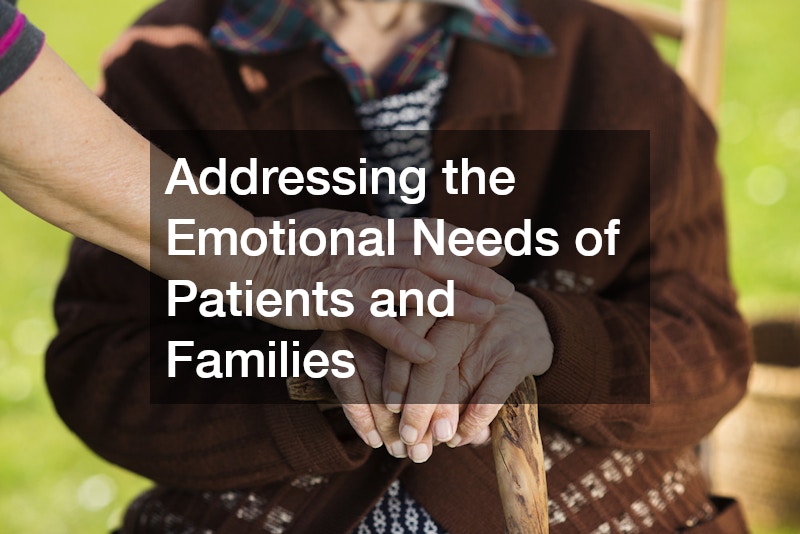How a Senior Care Navigator Can Guide Hospice Care Home Renovations
As our loved ones age, it becomes increasingly important to ensure that they have access to comfortable and safe living spaces, especially when end-of-life care may be a consideration. Creating a warm and inviting environment that supports their physical and emotional needs is essential in providing them with the dignity and peace they deserve during this stage of life. Collaborating with professionals such as home builders, roofers, and caregivers can help in designing spaces that are not only functional but also tailored to individual care needs.
A senior care navigator plays a crucial role in helping families navigate the complexities of end-of-life care, including finding suitable living arrangements and coordinating ongoing support services within the home. By working together with experienced professionals, families can ensure that their loved ones receive the best care possible in a setting that promotes comfort, safety, and independence.
Creating a comfortable living space for end-of-life care involves more than just physical changes to the home; it also requires addressing the emotional needs of patients and families. By designing quiet zones for rest and reflection, incorporating flexibility for changing health conditions, and maximizing safety without sacrificing warmth, it is possible to create an environment that fosters a sense of peace and security for everyone involved.
Collaborating With Professionals for Safe and Functional Design

When it comes to designing living spaces for end-of-life care, collaborating with professionals such as home builders, roofers, and caregivers is essential in creating safe and functional environments. Home additions, structural changes, and specialized renovations may be needed to accommodate the unique needs of patients, requiring expertise from experienced professionals who understand the complexities of senior care.
Home builders and custom home builders can help in creating spaces that are not only aesthetically pleasing but also meet the requirements for accessibility and safety. Roofers play a crucial role in ensuring that the home is structurally sound and free from potential hazards such as leaks or damage. By working with trusted experts in the field, families can rest assured that their loved ones are living in a space that is designed to support their health and well-being.
Incorporating services such as companion care and in-home care can further enhance the support provided to patients, offering assistance with daily activities and companionship to reduce feelings of isolation. Local caregivers who are familiar with the needs of seniors can provide personalized care that is tailored to the individual, ensuring that their physical and emotional needs are met with compassion and professionalism.
Enhancing Private Areas for Dignity and Peace
One of the key considerations when designing living spaces for end-of-life care is enhancing private areas to promote dignity and peace for patients. Creating private spaces where patients can rest and reflect without interruption is essential in supporting their emotional well-being and sense of self-worth during this challenging time.
By incorporating features such as en-suite bathrooms, comfortable seating areas, and personalized decor, it is possible to create a space that feels like home while also meeting the practical needs of patients. Custom home builders can work with families to design private areas that reflect the personal preferences and interests of patients, creating a space that is both functional and welcoming.
Ensuring that patients have access to quiet zones where they can retreat to find peace and solace is essential in promoting emotional wellness. By creating private areas that are free from distractions and noise, patients can find a sense of calm and tranquility, allowing them to rest and reflect in a space that is tailored to their needs.
Supporting Seamless Transitions With Thoughtful Layouts
Transitions can be challenging for patients and families, especially when it comes to moving into a new living space for end-of-life care. By designing thoughtful layouts that support seamless transitions, it is possible to create a space that feels familiar and comforting to patients, reducing feelings of anxiety and uncertainty during this time of change.
Working with senior care navigators can help in planning and coordinating the move to ensure that it is as smooth and stress-free as possible. By involving professionals who understand the needs of seniors and their families, it is possible to create a transition plan that takes into account the unique requirements of each individual, ensuring that they feel supported and cared for throughout the process.
Creating living spaces that are designed with transitions in mind can help patients feel more at ease in their new environment, promoting a sense of continuity and stability in their care. By incorporating familiar objects, routines, and personal belongings into the design of the space, it is possible to create a space that feels like home from the moment patients arrive.
Addressing the Emotional Needs of Patients and Families

End-of-life care is a challenging time for patients and families, filled with emotional ups and downs as they navigate the complexities of care and support. Designing living spaces that address the emotional needs of patients and families is essential in providing them with the comfort and peace they need during this difficult period.
By creating spaces that are warm, inviting, and supportive, it is possible to promote a sense of connection and understanding between patients and their loved ones. Incorporating features such as comfortable seating areas, calming decor, and personalized touches can help in creating an environment that feels safe and reassuring for everyone involved.
Senior care navigators can play a crucial role in providing emotional support to patients and families, helping them to navigate the challenges of end-of-life care with compassion and empathy. By working together with professionals who understand the emotional complexities of this stage of life, families can ensure that their loved ones receive the care and support they need to navigate this difficult time with grace and dignity.
Improving Accessibility With Thoughtful Structural Changes
Accessibility is a key consideration when designing living spaces for end-of-life care, as patients may have mobility challenges or require assistance with daily activities. Improving accessibility through thoughtful structural changes can help patients move safely and independently throughout the home, promoting their sense of autonomy and well-being.
Home additions, such as ramps, handrails, and wider doorways, can help in creating a space that is accessible to patients with mobility limitations. By working with home builders and roofers who specialize in creating accessible living spaces, it is possible to design a home that meets the unique needs of patients while also maintaining a welcoming and comfortable environment for all residents.
Incorporating features such as grab bars, non-slip flooring, and adjustable countertops can further enhance accessibility within the home, making it easier for patients to move around and perform daily tasks with ease. By creating a space that is thoughtfully designed with accessibility in mind, families can ensure that their loved ones can age in place comfortably and safely, without sacrificing their independence.
Designing Quiet Zones for Rest and Reflection
Quiet zones are essential in end-of-life care, providing patients with a space where they can retreat to find peace, rest, and reflection. By designing quiet zones that are free from noise and distractions, it is possible to create a serene environment where patients can relax and unwind, promoting their emotional well-being and sense of calm.
Utilizing soft lighting, calming decor, and comfortable seating can help in creating a space that is conducive to rest and relaxation. By incorporating elements of nature, such as plants or natural materials, it is possible to create a peaceful and rejuvenating environment where patients can find solace and comfort during this challenging time.
Quiet zones can also provide families with a space to recharge and reflect, offering a respite from the demands of caregiving and support. By creating designated areas for rest and reflection within the home, it is possible to promote a sense of balance and well-being for everyone involved, fostering a supportive environment that values the needs of both patients and their families.
Ensuring a Seamless Blend of Comfort and Practicality

Creating living spaces that seamlessly blend comfort and practicality is essential in providing patients with the support and care they need during end-of-life care. By combining elements of comfort, such as soft furnishings, warm lighting, and personalized decor, with practical features, such as accessibility aids, safety features, and functional layouts, it is possible to create a space that meets the needs of patients while also promoting their sense of well-being and independence.
Home builders and roofers play a crucial role in ensuring that the home is structurally sound, safe, and functional, while also creating a welcoming and comfortable environment for patients. By working with professionals who understand the unique requirements of end-of-life care, it is possible to design a space that is tailored to the individual needs of patients, providing them with the support and care they need to age in place with dignity and grace.
By focusing on creating a seamless blend of comfort and practicality within the home, families can ensure that their loved ones receive the best care possible in a space that feels warm, inviting, and supportive. By incorporating features that promote both physical and emotional well-being, it is possible to create a living space that enhances the quality of life for patients during this challenging stage of care.
Working With Trusted Experts for Specialized Renovations
Specialized renovations may be needed to create living spaces that are tailored to the unique needs of patients receiving end-of-life care. Working with trusted experts, such as home builders, roofers, and caregivers, can help in planning and executing renovations that support the health, safety, and well-being of patients, while also promoting their sense of comfort and dignity.
Home builders and custom home builders can provide expertise in creating shelters that are designed to meet the specific needs of patients, including accessibility modifications, safety features, and personalized touches. By working with professionals who specialize in end-of-life care, families can ensure that their loved ones receive the best care possible in an environment that is tailored to their individual needs.
Collaborating with caregivers and companion care providers can further enhance the support provided to patients, offering assistance with daily activities and emotional support to promote their sense of well-being. By working together with trusted experts in the field, families can create a living space that is designed to support the physical and emotional needs of patients receiving end-of-life care, ensuring that they receive the care and support they need to live with dignity and grace.
Tailoring Spaces to Individual Care Needs
Each patient has unique care needs that must be taken into account when designing living spaces for end-of-life care. By tailoring spaces to individual care needs, it is possible to create a supportive environment that meets the specific requirements of patients, fostering their sense of comfort, independence, and well-being during this challenging time.
Working with senior care navigators can help in identifying the care needs of patients and planning living spaces that are designed to support their health and well-being. By involving professionals who understand the complexities of end-of-life care, families can create a space that is tailored to the individual needs of patients, ensuring that they receive the care and support they need to live with dignity and grace.
Incorporating features such as adjustable furniture, specialized equipment, and personal care amenities can further enhance the support provided to patients, offering them the convenience and comfort they need to navigate their care with ease. By tailoring spaces to individual care needs, families can ensure that their loved ones receive the best care possible in an environment that is designed to support their unique requirements.
Coordinating Ongoing Support Services Within the Home

Coordinating ongoing support services within the home is essential in providing patients with the care and assistance they need to navigate end-of-life care with grace and dignity. By working with caregivers, companion care providers, and other professionals, it is possible to create a support network that promotes the health, safety, and well-being of patients, while also providing families with peace of mind and reassurance.
Home caregivers play a crucial role in providing personalized care to patients, offering assistance with daily activities, medication management, and emotional support. By coordinating ongoing support services within the home, families can ensure that their loved ones receive the care they need to age in place comfortably and safely, without sacrificing their independence.
Incorporating services such as hospice care, respite care, and palliative care within the home can further enhance the support provided to patients, offering them the specialized care and attention they need to navigate end-of-life care with dignity and grace. By coordinating ongoing support services within the home, families can create a nurturing and supportive environment that values the needs of patients and promotes their quality of life during this challenging time.
Conclusion
In conclusion, creating comfortable living spaces for end-of-life care involves collaborating with professionals, tailoring spaces to individual care needs, and promoting a seamless blend of comfort and practicality. By addressing the emotional needs of patients and families, improving accessibility with thoughtful changes, and incorporating flexibility for changing health conditions, it is possible to create a supportive environment that promotes the health, safety, and well-being of patients receiving end-of-life care. By working together with trusted experts and coordinating ongoing support services within the home, families can ensure that their loved ones receive the best care possible in an environment that values their dignity, independence, and peace.
